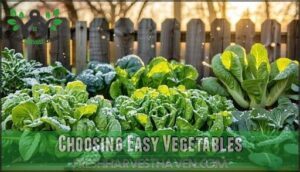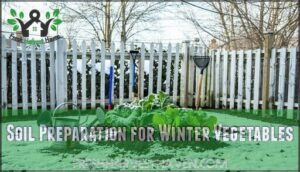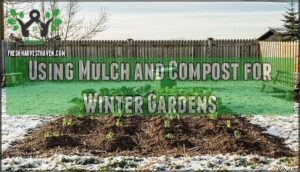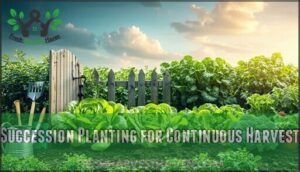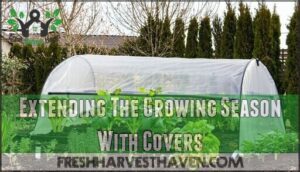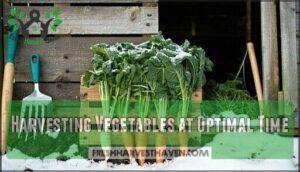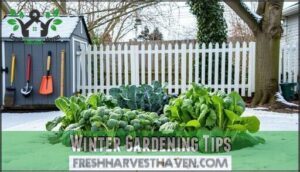This site is supported by our readers. We may earn a commission, at no cost to you, if you purchase through links.
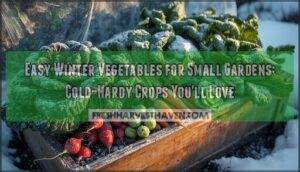
Kale, spinach, and arugula handle frost like champs, actually getting sweeter after cold snaps.
Radishes and carrots grow well in containers or raised beds, while Brussels sprouts pack serious nutrition into vertical space.
Mâche and winter lettuce keep producing even under snow.
These cold-hardy crops need less water and face fewer pests than summer vegetables, making them perfect for beginners.
Root vegetables like turnips store right in the soil, creating your own outdoor fridge.
With simple row covers or cold frames, you’ll harvest fresh greens all winter long while your neighbors wonder how you’re still picking dinner from your garden.
Table Of Contents
- Key Takeaways
- Winter Vegetable Options
- Choosing Easy Vegetables
- Preparing Winter Gardens
- Maximizing Winter Harvest
- Winter Gardening Tips
- Frequently Asked Questions (FAQs)
- What is the easiest vegetable to grow in winter?
- What is the fastest growing winter vegetable?
- What month do you plant winter vegetables?
- What are the easiest vegetables to grow and freeze?
- What are the easiest winter vegetables to grow?
- When should I start my winter vegetable garden?
- What vegetables go in the winter garden?
- What are the easiest cool weather vegetables to grow?
- Can I grow winter vegetables in containers?
- Do winter vegetables taste different from summer ones?
- Conclusion
Key Takeaways
- You’ll harvest sweeter vegetables after frost hits – carrots, kale, and parsnips actually taste better when cold weather converts their starches into natural sugars.
- Your small space can produce all winter long using containers and vertical growing methods with compact varieties like dwarf kale, spinach, and radishes that mature in just 4-6 weeks.
- You’ll face fewer pest problems and need less water with cold-hardy crops, making winter gardening easier for beginners than summer vegetables.
- You can extend your harvest season for months using simple protection like row covers or cold frames, keeping fresh produce flowing even under snow.
Winter Vegetable Options
You can grow fresh vegetables all winter long, even in a small garden space. Winter vegetables are surprisingly tough and many actually taste better after a light frost hits them.
Hardy Vegetables for Cold Climates
The toughest winter crops laugh at frost and keep producing when others quit.
Kale, spinach, and cabbage develop frost tolerance that makes them sweeter after cold snaps—nature’s way of rewarding your patience.
These hardy varieties thrive in cold climates, turning your small garden into a productive winter vegetable garden.
Cold weather crops like collards and Brussels sprouts show incredible climate resilience, surviving temperatures that would kill summer plants.
Coldhardy vegetables actually prefer the chill, making winter crops perfect for determined gardeners seeking reliable harvests.
Gardeners can explore cold tolerant vegetables to find the best options for their winter gardens.
Root Vegetables for Winter Harvest
Root vegetables are winter gardening gold. They get sweeter after frost hits, making them perfect cold hardy crops for your winter vegetable garden.
Mother Nature sweetens root vegetables with frost—her perfect recipe for winter garden success.
- Carrot Care: Plant mid-summer, mulch after first frost for protection
- Beet Harvest: Store in root cellars, harvest before ground freezes completely
- Parsnip Storage: Leave in ground under mulch all winter long
- Turnip Planting: Sow late summer for winter harvest timing
Leafy Greens for Small Gardens
Small gardens don’t mean small harvests. Kale varieties like ‘Dwarf Blue Curled’ thrive in containers, while spinach care requires minimal space and attention.
Choose lettuce types suited for winter frames—butterhead and romaine work well. Collard greens grow vertically, maximizing your square footage.
Bok choy matures quickly in tight spots. These leafy greens transform any small garden ideas into productive winter vegetable garden spaces with smart winter gardening tips for cold hardy success.
Choosing Easy Vegetables
When you’re dealing with limited space, you’ll want vegetables that pack maximum nutrition into minimum square footage.
Start with fast-growing crops like spinach and arugula that mature in just 4-6 weeks, then move on to compact powerhouses like kale and bok choy that thrive in containers and small beds.
Cold-Hardy Vegetables for Small Spaces
Winter kale, spinach, and Swiss chard excel in containers, making them perfect cold hardy crops for small gardens.
These vegetables show excellent frost tolerance while maximizing your limited space.
Here are three smart strategies for your winter vegetable garden:
- Choose compact varieties – Select dwarf kale and baby spinach for containers
- Stack vertically – Use tiered planters to grow more hardy roots upward
- Add cold frames – Protect tender leaves while extending your cold season crops harvest
These winter gardening tips help you grow fresh food year-round.
Vegetables With Short Maturity Dates
Quick-maturing fast growing veggies deliver quick harvest satisfaction in your winter vegetable garden.
Winter radish varieties mature in just 20-30 days, while spinach provides cold hardy leaves within 35-45 days.
These short season champions excel in small space gardening, with turnips and arugula ready in 30-40 days.
Cool season crops like lettuce and bok choy thrive as frost tolerant options, perfect for small garden vegetables that won’t keep you waiting all season long.
For more information on growing these crops, consider researching cold tolerant plants to maximize your winter harvest.
Preparing Winter Gardens
Success with winter gardening starts before the first frost hits your garden beds.
You’ll need to prep your soil, set up protection systems, and plan your mulching strategy to keep those cold-hardy crops thriving through the chilly months ahead, which includes being prepared for the first frost.
Soil Preparation for Winter Vegetables
Proper soil preparation sets the foundation for your winter vegetable garden success. Start by conducting soil testing to check your pH balance—most cold hardy vegetables prefer 6.0-7.0.
Here’s your essential checklist:
- Test soil pH and nutrient levels before planting
- Add 2-4 inches of compost for organic matter enrichment
- Improve drainage improvement by loosening soil 6-8 inches deep
- Apply organic fertilizers based on test results
- Spread mulch application 2-4 inches deep around plants
Compost addition transforms average dirt into nutrient-rich growing medium. Remove weeds completely—they’re troublemakers that harbor pests through winter.
Your small space gardening efforts pay off when soil stays healthy all season long. Accurate soil analysis requires using a soil testing kit to determine nutrient deficiencies.
Protecting Plants From Frost and Snow
Your garden’s survival depends on smart frost protection strategies that shield plants from winter’s harshest elements.
Row covers create protective microclimates while allowing light penetration. Cold frames act as mini-greenhouses, trapping solar heat during daylight hours. These snow barriers prevent damage from heavy accumulation that can crush delicate leaves.
Here’s your winter gardening guide for maximum frost tolerance:
- Install floating row covers before temperatures drop below freezing
- Build sturdy cold frames using recycled windows for budget-friendly protection
- Gently brush snow off covers to maintain light access and prevent structural damage
These cold hardy protection methods guarantee your vegetables thrive despite harsh conditions. Understanding frost formation basics is vital for developing effective winter gardening strategies.
Using Mulch and Compost for Winter Gardens
Two simple ingredients transform your winter vegetable garden into a thriving ecosystem.
Mulch types like straw, shredded leaves, or bark chips provide soil insulation that protects cold hardy crops from temperature swings. Apply three inches around plants, creating nature’s blanket.
Organic matter from compost enriches soil while compost tea feeds plants through winter. This winter fertilizer approach keeps your small gardens productive when other plots lie dormant.
Your vegetables will thank you. Using the right garden mulch options is essential for maintaining healthy soil.
Maximizing Winter Harvest
You’ve worked hard to grow your winter vegetables, and now it’s time to get the most from your garden.
Smart harvesting techniques and season-extending strategies will keep fresh produce flowing to your table all winter long.
Succession Planting for Continuous Harvest
Through strategic seed scheduling, your winter vegetable garden delivers fresh produce all season long. Succession planting transforms small gardens into productivity powerhouses.
Here’s your roadmap to continuous winter harvest:
- Sow leafy greens every 2-3 weeks – spinach and lettuce mature quickly for steady supplies
- Practice smart crop rotation – alternate plant families to maintain soil health and reduce pests
- Master harvest timing – pick outer leaves while centers keep growing
- Plan plant spacing carefully – dense plantings maximize yield management in compact areas
This approach keeps your cold hardy vegetables producing when others’ gardens sit empty.
Extending The Growing Season With Covers
Cold frames consistently offer the best season extension for your winter vegetable garden.
Row covers provide essential frost protection while allowing light through. Garden cloches create mini-greenhouses around individual plants.
Winter tunnels with proper ventilation prevent mold while protecting cold hardy crops.
These covers extend your harvest by weeks or months, keeping vegetables thriving when temperatures drop below their normal tolerance levels.
Using the right row cover materials is vital for maintaining a healthy winter garden.
Harvesting Vegetables at Optimal Time
Perfect frost timing transforms your winter harvest into something special.
You’ll notice carrots and parsnips develop remarkable sweetness after cold exposure—nature’s way of concentrating flavors.
Monitor your cold-hardy crops closely through crop monitoring, checking for firm roots and vibrant colors that signal peak readiness.
Smart harvest scheduling means picking before vegetables become woody or bitter.
Store properly to extend your winter harvest enjoyment—your small garden’s yield optimization depends on this careful seasonal planning and timing balance.
Winter Gardening Tips
Successfully growing winter vegetables requires attention to three critical areas that’ll make or break your cold-season garden.
You’ll need to stay on top of pest management, create the right protective environment, and keep your soil healthy throughout the winter months.
Managing Pests and Diseases in Winter
Winter pest control starts with thorough winter sanitation – remove all plant debris where pests hide.
Disease prevention improves when you prune damaged leaves early and clear weeds that harbor pathogens.
Organic solutions like neem oil and diatomaceous earth target common winter pests safely.
Regular inspection helps you spot trouble before it spreads.
Row covers provide frost protection while blocking insects from reaching your cold hardy vegetables naturally.
Using Greenhouses and Cold Frames
Your small greenhouse or cold frame becomes your winter gardening secret weapon, keeping plants cozy when Jack Frost comes knocking. These structures trap warmth and shield crops from harsh winds, creating a microclimate that’s 10-20°F warmer than outside temperatures.
Greenhouse Designs range from simple lean-to models against your house to freestanding units. Cold Frame Tips include positioning them south-facing for maximum sun exposure and using thermal mass like water jugs to store daytime heat.
To further enhance soil health, consider incorporating organic soil amendments.
- Layer bubble wrap or fleece inside for extra insulation during bitter cold snaps.
Your Winter Protection setup enables Season Extension well into spring. Smart Frost Management with automatic vents prevents overheating on sunny days while maintaining steady temperatures for your cold-hardy crops.
Maintaining Soil Health in Winter Gardens
While greenhouses and cold frames provide excellent protection, your soil needs year-round attention to support healthy winter vegetables.
Healthy soil starts with testing soil pH in late summer—frozen ground makes nutrient absorption nearly impossible. Compost application before fall planting adds essential organic matter that feeds your plants through winter’s harsh conditions.
Mulch acts like a winter blanket, protecting roots while improving nutrient retention. Use straw, leaves, or bark chips around your vegetables. Cover crops like winter rye fix nitrogen and prevent soil erosion when planted in unused bed sections.
Winter weeding requires patience—don’t pull frozen weeds since their roots actually stabilize soil structure. Focus on drainage improvement by adding organic matter to prevent waterlogged conditions that kill roots.
soil structure
Maintaining soil health during winter guarantees your garden bounces back stronger in spring.
Frequently Asked Questions (FAQs)
What is the easiest vegetable to grow in winter?
Here’s your secret weapon: spinach laughs at frost and practically grows itself.
You’ll plant seeds 6-8 weeks before your first freeze, then watch them thrive in cold weather that kills other crops.
What is the fastest growing winter vegetable?
Kohlrabi grows fastest in winter, maturing in just 6-10 weeks before frost hits. You’ll harvest these space-saving bulbs quickly, making them perfect for impatient gardeners wanting fresh winter produce.
What month do you plant winter vegetables?
You’ll want to plant winter vegetables in mid-summer to early fall, typically July through August.
This timing gives crops like kale, carrots, and spinach enough time to establish before frost hits your garden.
What are the easiest vegetables to grow and freeze?
Looking to stock your freezer with homegrown goodness?
You’ll hit the jackpot with peas, green beans, broccoli, spinach, and corn.
These vegetables freeze beautifully, retain their nutrients, and you’ll harvest them quickly without fuss.
What are the easiest winter vegetables to grow?
Kale, spinach, and carrots are your best bets for winter gardening success. They’re frost-hardy, sweeten after cold snaps, and require minimal protection to thrive through freezing temperatures.
When should I start my winter vegetable garden?
Think you’ll just throw seeds in snow and call it gardening?
Start your winter vegetable garden in mid-summer to early fall.
Plant cold-hardy crops 6-12 weeks before your first expected frost date for successful winter harvests.
What vegetables go in the winter garden?
Hardy greens like kale, spinach, and collards handle frost beautifully. Root vegetables including carrots, beets, and turnips sweeten after cold exposure. Brussels sprouts and broccoli thrive in chilly weather too.
What are the easiest cool weather vegetables to grow?
Spinach, kale, and carrots are your best bets for beginners. They’re practically bulletproof in cold weather, need minimal care, and actually taste sweeter after frost hits your garden.
Can I grow winter vegetables in containers?
Yes, you can successfully grow winter vegetables in containers.
Choose compact varieties like spinach, kale, lettuce, and radishes.
Use deep pots with drainage holes, quality potting soil, and protect containers from freezing temperatures with mulch or moving them to sheltered areas to ensure the successful growth of your winter vegetables.
Do winter vegetables taste different from summer ones?
Frost transforms winter vegetables, making them sweeter and more flavorful. Cold converts starches into sugars, so you’ll taste enhanced sweetness in carrots, kale, and parsnips compared to their summer counterparts.
Conclusion
Think of your winter garden as nature’s refrigerator – keeping fresh produce crisp and ready when you need it most.
Growing easy winter vegetables for small gardens transforms cold months into harvest season. You’ll enjoy nutrient-dense crops that actually improve with frost exposure.
These hardy vegetables require minimal maintenance while delivering maximum flavor. Start planning your winter garden now, and you’ll discover that small spaces can produce big rewards throughout the coldest months, with fresh produce and maximum flavor.

